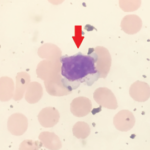Laboratory Tests
Differential diagnosis helps determine which laboratory tests to order, said Dr. Miller. Consider SLE in differential diagnosis for children who present with arthralgias as well.
Up to half of children with active synovitis and juvenile arthritis have normal erythrocyte sedimentation rates, he stressed.2 Over time, repeat blood tests may help diagnose the cause of unexplained pain.
“I’ve had patients with normal differentials who then had neutropenia on a subsequent test. One child had leukemia. Children with leukemia don’t always have abnormal blood tests, so it may be helpful to repeat these tests over a few months while they’re having symptoms. There are cases of children with leukemia presenting with a definite synovitis, but usually the pain is over the metaphysis,” said Dr. Miller.
Fevers & Back Pain
Children with arthralgias but normal joint exams may present with other symptoms, such as prolonged fevers. In these cases, patients may need to be admitted to the hospital for thorough malignancy and infection workups, Dr. Miller said. An echocardiogram helps detect other causes of pain with fevers and other symptoms, such as non-specific rashes. These include coronary arterial aneurysm, Kawasaki disease, thickening of the mitral valve or pericardial effusion in children with systemic JIA. Depending on the particular presentation, auto-inflammatory diseases may need to be considered.
“Even if one doesn’t hear a heart murmur, but the patient has adenopathy, fevers and non-specific rash—along with arthralgias—think about [ordering] an echocardiogram. It’s a good routine test,” said Dr. Miller.
Back pain has a broad differential diagnosis in children. Dr. Miller shared a case of a child with persistent, moderate to severe back pain and trouble walking, but a normal examination and X-rays. An MRI revealed intraspinal metastatic lesions. This patient was later diagnosed with acute lymphocytic leukemia.
Children cannot always localize back pain. “I often can’t use a child’s or parent’s reported history to determine what part of the spine to image. I have seen abnormalities in the MRI not located where they were reporting the pain,” Dr. Miller said.
Back pain may occur in spondylolisthesis; infections, such as intraspinal abscess or vertebral osteomyelitis; tethered cord; syrinx; Chiari malformation; spinal cord tumors; or acute lymphocytic leukemia.
Children with back pain who cannot walk should always be admitted to the hospital for further evaluation, said Dr. Miller. Possible diagnoses associated with these symptoms include early septic arthritis, early osteomyelitis, spinal abscess or tumor, as well as physical or sexual abuse.



